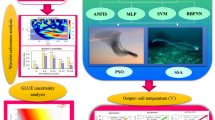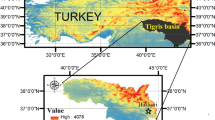Abstract
Evaporation is one of the major components of the hydrological cycle and its accurate estimation affects water resource management, irrigation planning, and environmental studies. In this paper, an explicit mathematical function was proposed based on the response surface function (RSF) to predict pan evaporation. The second-order RSFs were found to be more efficient and accurate than the linear RSF. The ability of the proposed RSF-based method was investigated with a wavelet-based adaptive neuro-fuzzy inference system (WANFIS) and wavelet-based support vector regression (WSVR) to estimate the daily evaporation of the pan. Daily climatic variables such as wind speed, sunshine hour, air temperature, and relative humidity from two climate stations (Chahnimeh and Pishien reservoirs) in Iran were used as inputs in all models. The modelling results were evaluated using RMSE, d, NSE, CI, and R2 in both regions. RSF, WANFIS, and WSVR all could be successfully employed in modelling the evaporation estimation. WANFIS model shows the best results and its estimated statistics factors in Chahnimeh are RMSE = 3.05, NSE = 0.90, d = 0.98, CI = 0.88, and R2 = 0.98 and for Pishien are RMSE = 1.51, NSE = 0.84, d = 0.96, CI = 0.81, and R2 = 0.92. Also, the RSF model provides satisfactory results similar to the WSVR model.








Similar content being viewed by others
Data availability
Some or all data, models, or codes generated or used during the study are available from the corresponding author by request. This includes (1) average daily temperature (T), average daily wind speed (U), average daily sunshine hours (Hs), average daily relative humidity (RH), and average daily pan evaporation (Ep) and (2) scripts and functions to filter raw data and scripts with the models presented in this paper.
References
Acreman MC, Harding RJ, Lloyd CR, McNeil DD (2003) Evaporation characteristics of wetlands: experience from a wetgrassland and a reedbed using eddy correlation measurements. Hydrol Earth Syst Sci 7(1):11–21
Adnan RM, Malik A, Kumar A, Parmar KS, Kisi O (2019) Pan evaporation modeling by three different neuro-fuzzy intelligent systems using climatic inputs. Arab J Geosci 12:1–14
Allaix DL, Carbone VI (2011) An improvement of the response surface method. Struct Saf 33:165–172
Alslaibi TM, Abustan I, Ahmad MA, Foul AA (2013) A review: production of activated carbon from agricultural byproducts via conventional and microwave heating. J Chem Technol Biotechnol 88:1183–1190
Box GE, Wilson KB (1951) On the experimental attainment of optimum conditions. J Roy Stat Soc: Ser B (Methodol) 13:1–38
Chang F-J, Chang Y-T (2006) Adaptive neuro-fuzzy inference system for prediction of water level in reservoir. Adv Water Resour 29:1–10
Chang F-J, Chang K-Y, Chang L-C (2008) Counterpropagation fuzzy-neural network for city flood control system. J Hydrol 358:24–34
Chen Y, Song L, Liu Y, Yang L, Li D (2020) A review of the artificial neural network models for water quality prediction. Appl Sci 10:5776. https://doi.org/10.3390/app10175776
El-Mahdy ME-S, El-Abd WA, Morsi FI (2021) Forecasting lake evaporation under a changing climate with an integrated artificial neural network model: a case study Lake Nasser, Egypt. J African Earth Sci 179:104191
Falamarzi Y, Palizdan N, Huang YF, Lee TS (2014) Estimating evapotranspiration from temperature and wind speed data using artificial and wavelet neural networks (WNNs). Agric Water Manag 140:26–36
Ghorbani-Choghamarani A, Hajjami M, Goudarziafshar H, Nikoorazm M, Mallakpour S, Sadeghizadeh F, Azadi G (2009) Catalytic oxidation of urazoles and bis-urazoles to their corresponding triazolinediones using aluminium nitrate and a catalytic amount of silica sulfuric acid. Monatshefte Für Chemie-Chemical Monthly 140:607–610
He Z, Xiao B, Liu F, Wu H, Yang Y, Xiao S, Wang C, Russell TP, Cao Y (2015) Single-junction polymer solar cells with high efficiency and photovoltage. Nat Photonics 9:174–179
Kang M (2010) Measuring social media credibility: A study on a measure of blog credibility. In: Technical Report S. I. Newhouse School of Public Communications, Syracuse University
Kaymaz I, McMahon CA (2005) A response surface method based on weighted regression for structural reliability analysis. Probab Eng Mech 20:11–17
Keshtegar B, Piri J, Kisi O (2016) A nonlinear mathematical modeling of daily pan evaporation based on conjugate gradient method. Comput Electron Agric 127:120–130
Keshtegar B, Heddam S, Sebbar A, Zhu SP, Trung NT (2019) SVR-RSM: a hybrid heuristic method for modeling monthly pan evaporation. Environ Sci Pollut Research 26(35):35807–35826. https://doi.org/10.1007/s11356-019-06596-8
Khodabandeh F, DehghaniDarmian M, AzhdaryMoghaddam M et al (2021) Reservoir quality management with CE-QUAL-W2/ANN surrogate model and PSO algorithm (case study: Pishin Dam, Iran). Arab J Geosci 14:401. https://doi.org/10.1007/s12517-021-06735-x
Kisi O, Cimen M (2011) A wavelet-support vector machine conjunction model for monthly streamflow forecasting. J Hydrol 399:132–140
Kisi Ö (2006) Daily pan evaporation modelling using a neuro-fuzzy computing technique. J Hydrol 329:636–646
Kisi Ö (2009) Modeling monthly evaporation using two different neural computing techniques. Irrig Sci 27:417–430
Manning JC (2016) Applied principles of hydrology. Waveland Press
Meier C, Penny RW, Zou Y, Gibbs JS, Hart AJ (2017) Thermophysical phenomena in metal additive manufacturing by selective laser melting: fundamentals, modeling, simulation, and experimentation. Annu Rev Heat Transf 20. https://doi.org/10.1615/AnnualRevHeatTransfer.2018019042
Moghaddamnia A, Gousheh MG, Piri J, Amin S, Han D (2009) Evaporation estimation using artificial neural networks and adaptive neuro-fuzzy inference system techniques. Adv Water Resour 32:88–97
Mosner MS, Aulenbach BT (2003) Comparison of methods used to estimate lake evaporation for a water budget of Lake Seminole, southwestern Georgia and northwestern Florida. Georgia Institute of Technology
Piri J, Amin S, Moghaddamnia A, Keshavarz A, Han D, Remesan R (2009) Daily pan evaporation modeling in a hot and dry climate. J Hydrol Eng 14:803–811
Piri J, Ansari H (2013) Daily pan evaporation modelling with ANFIS and NNARX. Iran Agricultural Research 31(2):51–64
Piri J, Kisi O (2015) Modelling solar radiation reached to the Earth using ANFIS, NN-ARX, and empirical models (case studies: Zahedan and Bojnurd stations). J Atmos Solar Terr Phys 123:39–47
Piri J, Shamshirband S, Petković D, Tong CW, urRehman MH (2015) Prediction of the solar radiation on the earth using support vector regression technique. Infrared Physics Technol 68:179–185
Qasem SN, Samadianfard S, Kheshtgar S, Jarhan S, Kisi O, Shamshirband S, Chau K-W (2019) Modeling monthly pan evaporation using wavelet support vector regression and wavelet artificial neural networks in arid and humid climates. Eng Appl Comput Fluid Mech 13:177–187
Quiroga RQ, Sakowitz OW, Basar E, Schürmann M (2001) Wavelet transform in the analysis of the frequency composition of evoked potentials. Brain Res Protocol 8(1):16–24
Rajashekhar MR, Ellingwood BR (1993) A new look at the response surface approach for reliability analysis. Struct Saf 12:205–220
Roushangar K, Koosheh A (2015) Evaluation of GA-SVR method for modeling bed load transport in gravel-bed rivers. J Hydrol 527:1142–1152
Sanchez PJ (2007) Fundamentals of simulation modeling. In: 2007 Winter Simulation Conference. IEEE, pp 54–62
Shirsath PB, Singh AK (2010) A comparative study of daily pan evaporation estimation using ANN, regression and climate based models. Water Resour Manage 24:1571–1581
Tabari H, Martinez C, Ezani A, Talaee PH (2013) Applicability of support vector machines and adaptive neurofuzzy inference system for modeling potato crop evapotranspiration. Irrig Sci 31:575–588
Thomas S, Pillai G, Pal K (2017) Prediction of peak ground acceleration using ϵ-SVR, ν-SVR and Ls-SVR algorithm. Geomat Nat Haz Risk 8:177–193
Wei G-L, Li D-Q, Zhuo M-N, Liao Y-S, Xie Z-Y, Guo T-L, Li J-J, Zhang S-Y, Liang Z-Q (2015) Organophosphorus flame retardants and plasticizers: sources, occurrence, toxicity and human exposure. Environ Pollut 196:29–46
Willmott CJ, Ackleson SG, Davis RE, Feddema JJ, Klink KM, Legates DR, O’donnell J, Rowe CM (1985) Statistics for the evaluation and comparison of models. J Geophys Res: Oceans 90:8995–9005
Willmott CJ, Matsuura K (2006) On the use of dimensioned measures of error to evaluate the performance of spatial interpolators. Int J Geogr Inf Sci 20:89–102
Wurbs RA, Ayala RA (2014) Reservoir evaporation in Texas, USA. J Hydrol 510:1–9
Author information
Authors and Affiliations
Corresponding authors
Ethics declarations
Conflict of interest
The authors declare no competing interests.
Additional information
Responsible Editor: Broder J. Merkel
Rights and permissions
Springer Nature or its licensor (e.g. a society or other partner) holds exclusive rights to this article under a publishing agreement with the author(s) or other rightsholder(s); author self-archiving of the accepted manuscript version of this article is solely governed by the terms of such publishing agreement and applicable law.
About this article
Cite this article
Piri, J., Mollaeinia, M. & Mostafaie, A. Assessment of response surface method and hybrid models to predict evaporation (case study: Chahnimeh and Pishein reservoirs in Sistan and Baluchestan Province of Iran). Arab J Geosci 16, 346 (2023). https://doi.org/10.1007/s12517-023-11330-3
Received:
Accepted:
Published:
DOI: https://doi.org/10.1007/s12517-023-11330-3




